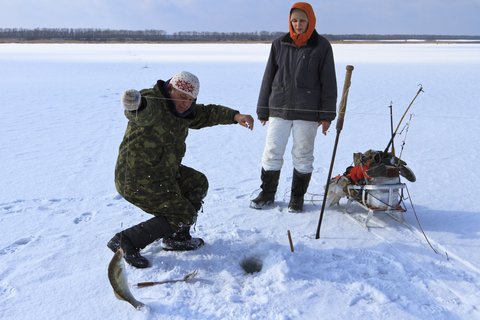In a simpler time, fishing line was fishing line, and the same spool lasted throughout the year, from the walleye opener in the spring, right through ice-fishing season. But those days are gone.
Today, advances in line construction have produced a new breed of fishing line specifically designed for cold weather angling. These technological advances have revolutionized ice fishing, but they also create a new dilemma for anglers, who must select a winter line that meets their angling needs.
The choices may seem confusing, but if you keep a few key elements in mind when selecting a line, you are certain to find a brand that meets your requirements.
One of the most important factors to consider is stiffness. Monofilament lines designed for warm-weather angling often become stiff when the mercury drops below the freezing mark. Stiff line impedes the action of your bait and reduces the odds of catching fish. Specialized cold-weather monofilament lines are designed to stay flexible, even when the temperature falls below zero.
Along with stiffness, another important factor is stretch. Monofilament lines designed for summer angling do not stretch the same in cold weather. Some winter monofilament lines are specifically marketed as low-stretch lines, which provide better control of your bait and increased sensitivity.
Some anglers steer clear of monofilament lines altogether during the winter months, because they feel other lines provide better flexibility and strength.
Other varieties of lines, like fluorocarbon line, claim to remain more flexible in cold weather and are less likely to become brittle. They boast exceptional flexibility in cold weather, along with the added strength associated with fire-wire lines.
Copolymer lines are marketed as high-strength, low-wear, high-flexibility alternatives to monofilament lines.
Another factor to keep in mind in the line-selection process is visibility. Line is easier for fish to see during the winter months, in part because they have a longer time to inspect a bait before taking it. Visibility also comes into play when light streams down from the hole into the dark water and creates a silhouette of the line. Low visibility, low diameter lines help reduce the odds of a fish seeing your line and rejecting the bait.
Anglers should also consider durability. When your line is rubbing against the edges of the ice in the hole, it can damage less durable line. You want a line that will hold up, with reduced chances for nicks and cuts.
The ultimate goal is to catch more fish and specialized ice-fishing lines provide anglers with an added edge toward that goal. However, no one brand or variety of line is perfect for every angler. It may require some experimentation to find the line that best suits your angling needs, but once you walk away from the age-old practice of using one line throughout the year, you are headed in the right direction.
Photo credit: Dreamstime








